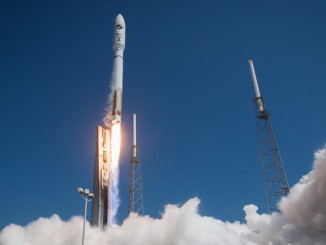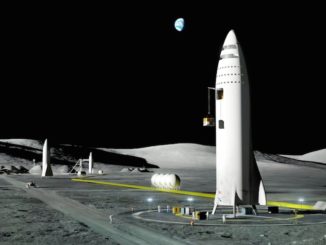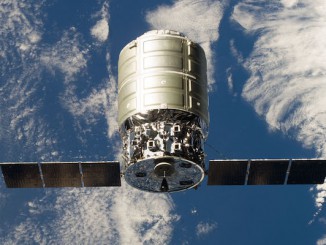
Update Dec. 13: Falcon Heavy is returning to the hangar and launch of USSF-52 mission is on hold.
Update Dec. 12: SpaceX and SSC are now targeting launch of the USSF-52 mission at 8:13 p.m. EST (0113 UTC) on Wednesday, Dec. 13.
Update Dec. 11: SpaceX is standing down from its launch attempt of the USSF-52 mission due to “a ground side issue.” The scrub was followed by a delay of the Falcon 9 launch for the Starlink 6-34 mission as well.
SpaceX said they are looking at a backup opportunity no earlier than Tuesday, Dec. 12, at 8:14 p.m. EST (0114 UTC).
Original story:
The fifth and final Falcon Heavy mission of 2023 is preparing to launch from NASA’s Kennedy Space Center carrying the X-37B, a secretive spaceplane operated by the U.S. military. The mission, code-named U.S. Space Force (USSF)-52, is set for liftoff during a ten-minute window on Monday, Dec. 10, that opens at 8:14 p.m. EST (0114 UTC).
The mission had been scheduled to liftoff Sunday evening but was delayed 24 hours. In a post on social media, SpaceX did not provide a specific reason for the delay, but stated it would allow “time to complete additional pre-launch check outs.”
This will be the seventh mission for the X-37B Orbital Test Vehicle (OTV) since its space debut in 2010 and the first time it has flown aboard the triple-booster Falcon Heavy rocket. SpaceX launched the fifth OTV mission in September 2017 on a Falcon 9. The other five flights of the spaceplane used the United Launch Alliance Atlas 5 501 rocket.
Spaceflight Now will have live coverage of the mission starting an hour and 30 minutes ahead of liftoff.
As with prior flights of the military spaceplane, much about the mission remains undisclosed, including it’s orbit and activities after liftoff. In a statement the U.S. Space Force said: “The use of a Falcon Heavy rocket will expand the X-37B flight envelope, launching into a new orbital regime, and enabling unique experimentation opportunities for the X-37B.”
Based on notices issued to mariners and aviators related to the impact zones for the first and second stages, the Falcon Heavy will take a northerly trajectory from Cape Canaveral and might perform a so-called ‘dog leg’ maneuver to reach a high inclination orbit.
Charles Galbreath, a Senior Fellow for Space Studies at the Mitchell Institute’s Spacepower Advantage Center of Excellence (MI-SPACE), said that from an outsider’s perspective, he’s interested to see how these “new orbital regimes” play out for the vehicle.
“The fact that it’s on a Falcon Heavy suggests to me that you’re not just going to a medium Earth orbit altitude here,” Galbreath said.
Galbreath spent 30 years as part of the U.S. Air Force and then the Space Force, but always in a space-focused role. His last role before retiring from active service was as the Deputy Chief Technology and Innovation Officer for the Space Force.
During the 90s and early 00s, he was also part of a precursor to the X-37B, the Boeing-built X-40 Space Maneuver Vehicle. That work as part of the Developmental Planning Directorate at the Los Angeles-based Space and Missile System Center helped test some functions that would be explored further with the X-37B.
“There were a lot of great studies that were done. We identified a wide range of potential missions from ISR (intelligence, surveillance and reconnaissance) to position, navigation and timing to communications in general as well as the potential for science and technology experiments, which is what it’s been used for a lot,” Galbreath said.
“But you know, the ability to deploy a free-flyer that could have some other capability, that might hold an adversary’s asset at risk is an interesting prospect as well and one I hope that our adversaries are thinking about and are worried about.”

Galbreath was also stationed at Vandenberg Air Force Base (now Vandenberg Space Force Base) when the X-37B OTV-2 mission landed. He said the spacecraft is a great tool not only for its reusability, but also as a way to engage the public at large, since conveying missions with renderings isn’t as stimulating as seeing real hardware.
“I think anything that can help accelerate the thinking and the excitement about space is valuable not just for the Space Force, but for the space community at large,” he said.
Expanding capabilities
In addition to the new orbital possibilities that officials say the X-37B will strive for on the OTV-7 mission, there will also be technology demonstrations. A detailed list of those flying onboard hasn’t been disclosed, but an Air Force press statement said the payloads on board “will expand the United States Space Force’s knowledge of the space environment by experimenting with future space domain awareness technologies. These tests are integral in ensuring safe, stable, and secure operations in space for all users of the domain.
“The X-37B continues to equip the United States with the knowledge to enhance current and future space operations. X-37B Mission 7 demonstrates the USSF’s commitment to innovation and defining the art-of-the-possible in the space domain,” said Gen. B. Chance Saltzman, the Chief of Space Operations, in a statement.”

One of the disclosed experiments is NASA’s Seeds-2, which Maj. Tanya Downsworth, a spokesperson for the U.S. Space Force, described as “testing the unique conditions of interplanetary spaceflight by exposing the seeds and materials to the radiation environment of space.”
“These experiments are vital to understanding how humanity can carry out long-duration manned missions in space and represent a core tenet of the X-37B’s mission to provide easier access to space for America’s scientists and engineers,” she added.
During OTV-6, which launched on May 17, 2020, and landed at NASA’s Kennedy Space Center on Nov. 12, 2022, the U.S. Naval Research Laboratory performed a demonstration of capturing solar energy from space, using the Photovoltaic Radio-frequency Antenna Module (PRAM) payload.
“Solar power satellites could be used internationally to support humanitarian missions as well as support military operations,” said Chris DePuma, the PRAM program manager, about a year into the test. “These are designed to collect solar energy in space where it is readily available, and then function as a power plant in the sky that is capable of delivering energy wherever it is most needed.”
While there aren’t any current, public plans for the X-37B to have a role in the cislunar architecture, Galbreath said it may help inform some of those designs down the road.
“As we continue out to the cislunar environment, we’re going to need to have a lot of vehicles that have maneuver capability to get from the Lagrange points, for example, to lunar orbit or to Earth orbit and potentially land, one way or the other, on the Earth and the Moon,” Galbreath said. “So, I think the maneuver aspect that is demonstrated by the X-37 is going to pave the way for some of those future missions in the cislunar environment.”
Falcon Heavy and national security
The USSF-52 mission is also important for the U.S. Space Systems Command (SSC) and its partnership with SpaceX.
Originally, the mission was set to launch during the summer, which would’ve seen the two side boosters on the Falcon Heavy, B1064 and B1065, fly following the USSF-44 and USSF-67 missions successively. However, a launch delay caused this mission to fly following launches for EchoStar and NASA.

Walt Lauderdale, the Mission Director and lead for Falcon Systems and Operations at SSC, told Spaceflight Now that this was the second opportunity for the Space Force to benefit from NASA’s prior evaluations of Falcon boosters. The first time being the launch of a Global Positioning System satellite in January this year.
“GPS 3 SV06 had first been flown for a crew mission and we took advantage of NASA’s work in evaluating that booster and we didn’t repeat what we didn’t need to,” Lauderdale said. “It was the first opportunity for us to actually benchmark our processes for nominal work against what NASA did and it was a good collaboration with NASA.”
He said the launch delay for USSF-52 also meant the side boosters have more previous flights than any other Falcon Heavy vehicle to date.
“It really sets the stage for some flexibility reuse as a whole because as busy as our manifest is going to be, and there’s always the potential for the missions moving around, being confident in any of the boosters that are in SpaceX’s inventory without us having to do a bunch of extra work is a tremendous benefit to us and the warfighter, in terms of bringing that capability on-orbit,” Lauderdale said.
SpaceX has two Falcon 9 first stage boosters that have each flown 18 times as the company is certifying its rockets up to 20 flights. Lauderdale said SSC doesn’t intend to become a flight leader with any of its missions, but said seeing the data from those boosters gives added confidence.
He also noted that there are a number of components that need to be evaluated on a Falcon booster when it comes to future flights and it’s not just the number of flights a booster has flown.
“It’s really about each, individual component: the engines, the plumbing, not just the structure, and what does that all see? How many flights? What is its qualification? What is its flight history?” Lauderdale explained. “And we’re taking advantage of all the information, together with SpaceX, to have confidence for our missions.”
Lauderdale said for now, they will continue using new payload fairings for each of their missions, but they are also examining fairing reuse down the road.
“Similar to booster reuse, you have to look at what environments has it seen, not just going up, but when it comes back down and then, what has it seen from getting ready to launch again,” Lauderdale said. “So, that’s one of the next steps we’re going to go through in addition to reuse count is to see if, in partnering with SpaceX, we can get confidence for our missions that we’re not taking any additional risk.”



